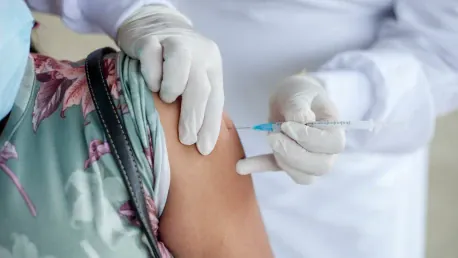Recent data from a comprehensive study published in The BMJ have revealed alarming and persistent inequalities in childhood vaccination rates across England, underscoring a major public health concern. The study meticulously analyzed general practice data from 2019 to 2023, revealing that vaccination uptake for five critical vaccines consistently fell short of the World Health Organization’s (WHO) recommended 95% target. These troubling trends were particularly pronounced among children in socioeconomically deprived areas, raising urgent questions about the effectiveness of current healthcare strategies.
Increasing Disparity in Vaccine Uptake
Socioeconomic Factors Affecting Vaccination Rates
The study examined the uptake rates of five specific vaccines: the first and second doses of the measles, mumps, and rubella vaccine (MMR1 and MMR2), the rotavirus vaccine, the pneumococcal conjugate vaccine (PCV) booster, and the vital six-in-one vaccine covering diphtheria, tetanus, pertussis, polio, Haemophilus influenzae type b, and hepatitis B. One of the most critical findings was that the disparity in vaccine uptake between the least and most deprived groups widened significantly over the study period. For instance, the difference in the six-in-one vaccine uptake grew from 3.3% to 7.4%, while the disparity in rotavirus vaccination uptake increased from 6.3% to 9.1%. Such differences underscore deep-rooted socioeconomic inequities impacting public health initiatives.
The disparities were not limited to just the six-in-one and rotavirus vaccines. The uptake difference in the PCV booster expanded from 5.6% to 8.6%, while MMR1 at age two showed a gap from 5.8% to 8.3%. Furthermore, the MMR2 vaccine, federally recommended for administration at age five, showed the most significant inequality, with the difference increasing from 5.3% to a staggering 11.5%. Even more alarming was the difference in MMR2 vaccine uptake given at age three years and four months, with the disparity escalating from 9.6% to 13.4%. These findings specify not only a widening gap in vaccine uptake but also stress the importance of addressing the socioeconomic factors fueling these disparities.
Incidence of Vaccine-Preventable Diseases
The increase in the number of children susceptible to measles at age five was notably dramatic, with a 15-fold rise in the least deprived group and a 20-fold rise in the most deprived group. Despite the overall decline in measles cases due to successful vaccination programs, the resurgence of susceptibility highlights the need for sustained and targeted public health efforts. Similar trends were observed with rotavirus, a common cause of severe diarrheal disease in young children, indicating that under-vaccination in deprived areas could lead to outbreaks of potentially serious illnesses.
Regional analysis further complicated the picture, showing that London had the lowest overall vaccination uptake, followed by the Midlands and North West. These regions also exhibited greater inequality compared to southern areas, suggesting regional disparities that compound the socioeconomic ones. The data indicate that children in certain parts of the country, particularly those in economically disadvantaged areas, are at greater risk of vaccine-preventable diseases. The potential for outbreaks in these communities is a significant public health concern, necessitating immediate and targeted interventions to bridge the vaccination gaps.
Urgent Need for Targeted Interventions
Improving Vaccination Systems in Deprived Areas
The study’s findings underscore the urgent need for enhanced vaccination systems and targeted interventions, particularly in underserved populations. One potential solution is implementing catchup campaigns to reach children who missed vaccinations. Ensuring that healthcare providers have the resources and support to conduct these campaigns effectively is critical. Strategies could include providing mobile vaccination units in hard-to-reach areas and employing community outreach programs to educate families about the importance of timely vaccinations. Leveraging local community leaders and trusted voices can also help combat misinformation and increase vaccine acceptance.
Despite some limitations in the study, such as potential data recording errors and unmeasured factors, the results provide strong evidence supporting the call for action to address these disparities. Strengthening childhood vaccination efforts proportionate to levels of need across different regions and socioeconomic groups is vital. Policymakers and healthcare organizations must collaborate to develop and implement policies that prioritize high-need areas, ensuring equitable vaccine access and improving overall public health. Moreover, monitoring and evaluating the effectiveness of these interventions will be essential to make necessary adjustments and optimize outcomes.
Policy Implications and Future Directions
The analysis highlights a critical public health issue requiring immediate response and systematic improvements. Effective policies should consider social determinants of health and integrate a multifaceted approach to vaccination programs. For instance, increasing funding for public health initiatives in deprived regions, improving access to primary healthcare services, and reducing barriers to vaccination access are crucial steps. Additionally, ensuring that public health messaging is culturally sensitive and accessible to diverse communities can help improve vaccination rates.
Future research should focus on identifying specific barriers to vaccination in socioeconomically deprived areas and evaluating the effectiveness of targeted interventions. Greater collaboration between public health researchers, healthcare providers, and policymakers is necessary to address these disparities comprehensively. By prioritizing the health needs of vulnerable populations and implementing evidence-based strategies, England can work towards meeting the WHO’s vaccination targets and protecting all children from vaccine-preventable diseases.
Conclusion
Recent findings from a thorough study published in The BMJ have highlighted disturbing and ongoing disparities in childhood vaccination rates throughout England, signifying a substantial public health issue. This detailed study scrutinized general practice data from 2019 to 2023, revealing that the uptake for five essential vaccines consistently fell short of the World Health Organization’s (WHO) recommended 95% threshold. These concerning trends were especially evident among children living in socioeconomically disadvantaged areas, raising urgent questions regarding the efficacy of the current healthcare approaches. The study’s revelations underscore the need to reevaluate and strengthen strategies to ensure equitable vaccine coverage for all children. Addressing these disparities is crucial for preventing outbreaks of vaccine-preventable diseases and fostering overall public health. The persistent inequality in vaccination rates reveals a systemic issue that demands immediate and effective interventions to protect the well-being of all children, regardless of their socioeconomic status.









